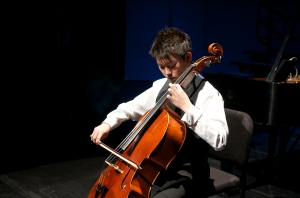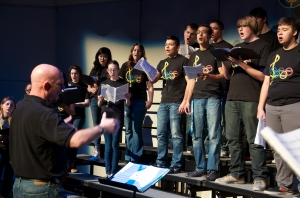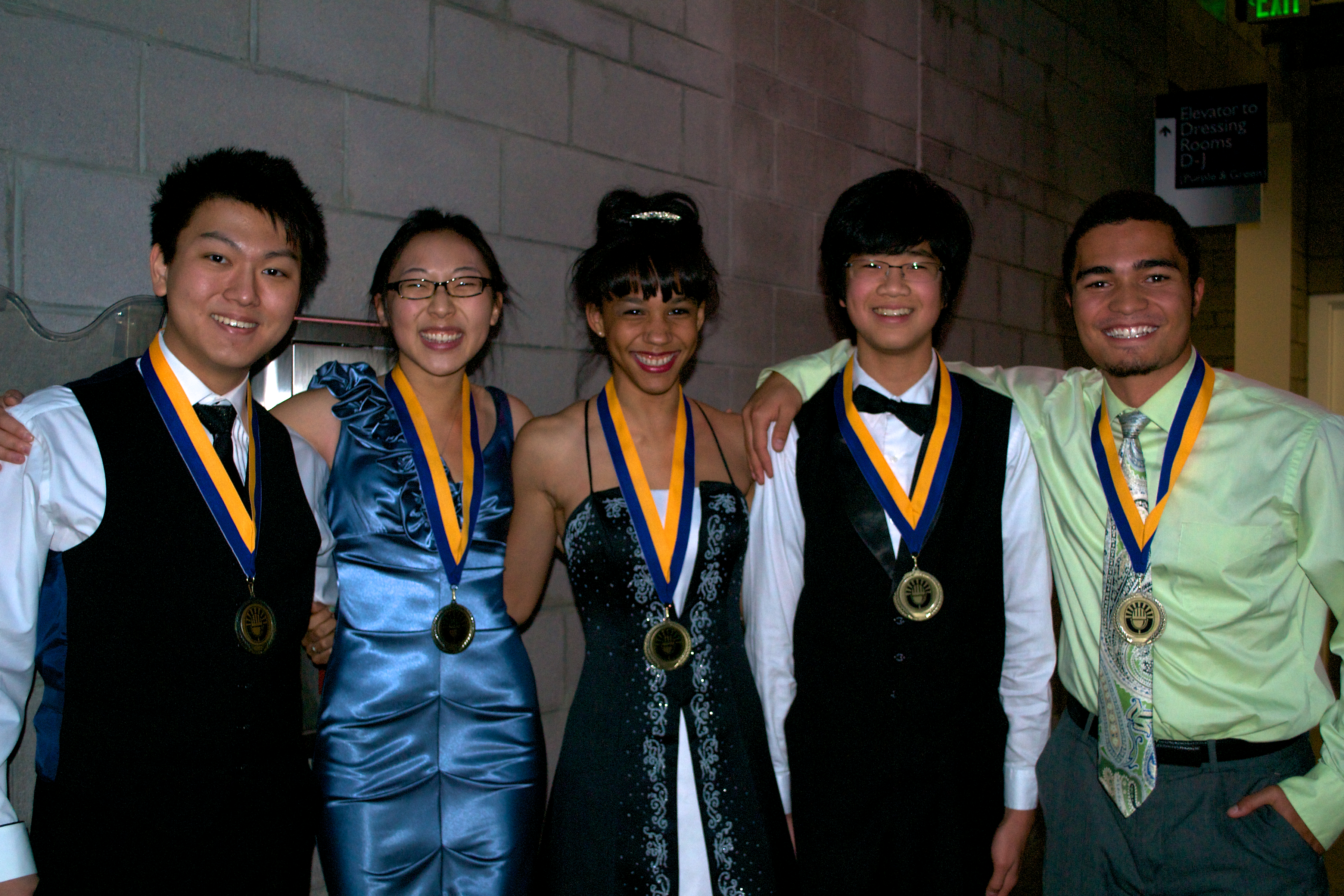Show 269: Listening Guide
From the Top’s broadcast for Show 269 was taped at the McCoy Center for the Arts in Mesa, AZ on Tuesday February 19, 2013. We asked our performers to tell us more about their experience on the show…
Austen Yueh, 16, clarinet
IV. Molto Allegro from Sonata in E-flat for Clarinet and Piano, Op.167
By: Camille Saint-Saëns
This movement is all about contrasts. One moment all you’re hearing are flashy, fast runs and scales, and the next moment it’ll be completely calm. It reminds me of a really exciting flight full of twists and turns, diving low and shooting back up in the technical passages. I think Saint-Saëns really knew how to exhibit the many personalities of the clarinet in this piece: the slightly show-off-y, attention-seeking, playing child; the shy and innocent girl; and the more mature romantic, which appears in the closing section. That’s definitely my favorite part, since it’s like a breath of fresh air when coming home after a long time away. Not to mention, the melody is essentially a beautiful love song without words.
Ultimately this movement represents life in a nutshell to me. We’re often very jumpy and eager, ready to dive into everything that comes our way. The main portion of the movement is bold and fast-paced, punctuated by moments of anxiety and breaks.  However, settling into the legato, cantabile melody in the closing reminds us that at the end of the day, we need to just sit back, chill, and enjoy the simple pleasures of life before we miss them and they’re gone.
However, settling into the legato, cantabile melody in the closing reminds us that at the end of the day, we need to just sit back, chill, and enjoy the simple pleasures of life before we miss them and they’re gone.
My first time hearing this piece was on a CD of Ricardo Morales at my teacher’s house. The sonata’s first movement has the same theme which appears in this movement’s closing, and I fell in love with it immediately. But what makes it more meaningful to me is that I performed this melody after the eulogy at my grandfather’s funeral in China. Seeing everyone’s faces soften despite the grief and the gravity of the situation was truly touching for me, and I think that was the moment where I realized music isn’t just about playing the right notes, having the best technique, or making a successful career. It’s about communicating and relating to people on a deeper level.
Post-Show Reflection: I really enjoyed all of the experiences with the performers outside the concert hall, especially the outreach events with the students from Archway Veritas and Rosie’s House. I was so thrilled to watch all of the other performers play onstage and interact with the students as well – the diversity and energy they brought were truly inspiring and I feel very fortunate to have been a part of that. Plus, I loved collaborating with Christopher O’Riley and getting to know the rest of the staff! And making a Harlem Shake video with everyone at the end of the arts leadership forum was a hilarious way to finish off. All in all, this has been one of my favorite musical experiences — it’s been both humbling and inspiring.
Music has the power to soften people’s hearts and to connect them in a way that is much deeper and closer to the core of what makes us human. As musicians, it’s so easy to get self-absorbed in your own actions and achievement, but music really is about humanity and communication. It is hope.
 Adé Williams, 15, violin
Adé Williams, 15, violin
IV. Presto agitato from the Sonata No.3 in D minor for Violin and Piano, Op.108
By: Johannes Brahms
The first time I played this piece was in Ludlow, VT City Hall when I was 11. It was my first time playing an entire sonata, which was really exciting. But since this movement is the last, I was so SO tired and exhausted. It felt like I had just run a marathon! I really love this piece; it’s my favorite Brahms sonata. Each movement is so different and awesome. The movement that I play is my closest second favorite to the first movement. It’s so exhilarating and fun to play, which is definitely my kind of music!
This movement is really unique. I can’t say that I’ve heard anything like it before. There are lots of pieces that are exciting in different ways, but I think this piece portrays certain wildness and intensity that you might not find in others. It’s also really mysterious in a way, but like a roller coaster at the same time! You’re always on your toes, and wondering what’s coming next!
Post-Show Reflection: This time being on From the Top was absolutely FANTASTIC! From playing the Brahms with Chris, to talking about how amazing Mr. Friend was, to hanging out with amazing other performers backstage, and doing hilarious things (Harlem Shake?) with them was soooooooo so so much fun. The staff is always wonderful and fun. Leading the bow was also really fun J It was an AMAZING experience and I can’t wait to come back.
 Peter Eom, 17, cello
Peter Eom, 17, cello
III. Allegro Molto Vivace from Sonata for Solo Cello, Op.8
By: Zoltán Kodály
Kodály wrote his solo cello sonata after visiting a bunch of tribal villages in Europe. He was inspired by the sheer number of cultures he was introduced to, and wrote the piece to express his culture shock. This is why you might notice some very unconventional sounds in his piece – virtuoso pizzicati, accentuated rhythms, harmonic shouts – in addition to the simplistic folk tunes. When hearing the sonata, you can almost imagine the villagers in their rustic dances and rituals – the music recreates their whoops and shouts, and their barbaric grunting and howling. This rural flavor to the piece makes it very schizophrenic because Kodály mixes it with very traditional, Hungarian composing – he frequently quotes the aristocratic (and very non-rustic) style of Hungarian concert music: nationalistic, proper music ful of pride and symmetry. By switching from this traditional Hungarian tone to lower-brow, folksy music, and then constantly back and forth, Kodály makes this piece an exciting creature indeed. I encourage audience members to listen for these different styles – it really helps in structuring the piece in your mind, and that’s always important when you want to keep yourself involved in the music. Another cool thing about the solo sonata is that it was the first thing written for solo cello since the Bach solo cello suites. Nobody knows why Kodály chose the cello, considered then as a long-forgotten instrument combo, to express how he felt about the different cultures. All I know is that: 1. Through his piece, Kodály gave the solo cello form new life, and composers from then on really started to contribute to the solo cello repertoire. 2. Every non-cellist wishes  that Kodály wrote something like this for his or her instrument – this is not even an opinion. It’s a fact – that’s just how cool this piece is.
that Kodály wrote something like this for his or her instrument – this is not even an opinion. It’s a fact – that’s just how cool this piece is.
The Solo Cello Sonata is considered one of the most difficult compositions ever written for cello – so in just that sense, Kodály’s piece is already very unique. However, as mentioned before, it introduces a lot of colors that are not found elsewhere in different pieces, and it is this flavor that really makes Kodály’s Solo Cello Sonata a special piece to enjoy. In no other majors piece are pizzicato, accentuated rhythms, and exotic solo cello chords so prominent. In addition, the piece requires that the cellist tunes his or her strings different from the traditional tuning of fifths (A, D, G, and C) – instead, the cellist tunes the G and C strings a half-step down, to F# and B. Through his use of scordatura to create a much less stable cello, now centered around a definite k (b minor), Kodály paints a polyphonic situation where the cello rings beyond its natural resonance and makes both the playing and the listening experience truly out of this world.
One really hard thing about this piece is that fact that it expresses something very simple – the pure emotion and feeling that is folk culture. As an artist, my job is to show this simplicity to the listeners; however, this is difficult to do due to the technical challenges of the piece, and how all over the place it is with its various special effects. I’ll try my best to emphasize the themes of the movement in the midst of everything, but will acknowledge that keeping it simple is one of the most challenging aspects of the piece.
Post-Show Reflection: From the Top was a beautiful experience for me – and all of us, I’m sure. I can’t believe that we were only together for 2 days! It’s a testament to the power of music – as we drove together, ate together, and listened to each other, something magical happened and we all found it so easy to relate to each other. It was as if we had grown up together. Ultimately, I found my time here and experiences have definitely given me new insight into the great things I can do for the future.
 Christopher Son Richardson, 14, piano
Christopher Son Richardson, 14, piano
III. Allegro con brio, ma non leggiere from Sonata No. 4 in C minor, Op. 29
By: Sergei Prokofiev.
I think that this piece is extremely fun to play. It is quite humorous, in my opinion, but it has its lyrical moments. I imagine a circus whenever I play this movement. For example, the very first few measures seem like someone doing a trapeze act. My favorite part to play is the climax. My brother tries to copy many times while he is practicing from another room during my practice, but he can never make it as fast, no matter how many times he tries – we always laugh about it.
Compared to the other piece that I have played, this piece requires a lot of energy from the performer. The hardest thing to nail, for me, is building the excitement, especially towards the big climax. I also have to make the dynamics very contrasting. The rhythm has to be precise. Another thing that makes this piece unique is its combination of lyricism, dynamism, sarcastic humor, and classicism.
Post-Show Reflection: My favorite memory from my FTT experience was when the students from Rosie’s House came backstage while everyone was eating (for a meet & greet session with the performers). I was less nervous that I thought I would be, and I thought it was really fun. The piano was great!
Music has the power to change people.
 Trey Pernell, 18, composer
Trey Pernell, 18, composer
Performed by the Phoenix Children’s Chorus
(Ron Carpenter – artistic director)
“O Captain! My Captain!”
By: Trey Pernell
I wrote “O Captain! My Captain!” with the image of a massive funeral procession in mind. I imagined a solemn spectacle befitting the death of such a revered figure (Abraham Lincoln) and tried to sound like the collective voice of the crowd, as they watched the casket pass by. Above all, you could say that I wanted to depict the emotions around a single scene, more than tell an entire story.
“O Captain! My Captain!” was my second choral composition and I wanted to get it right. I hadn’t been in choir for more than 3 months when I tried to write my first choral composition, inspired by all of the gorgeous music that I’d been introduced to. It was composed in the fervor of having discovered something new and exciting. Writing my first choral composition was  like taking a brand new car out for a ride, or painting after discovering a new color. I hadn’t really written music for the voice before so I was thinking to myself, ‘Let’s see what I can do with these new tools.’ The first piece ended up being sloppily written and hastily finished. Several months later, however, when I began writing “O Captain! My Captain!,” I was determined to keep it from collapsing. “O Captain!” is special to me because ever since I’d joined choir, I wanted ot write a substantial choral piece, and it represents my success. There’s nothing like completing your first composition, and completing “O Captain!” brought a little bit of that feeling back.
like taking a brand new car out for a ride, or painting after discovering a new color. I hadn’t really written music for the voice before so I was thinking to myself, ‘Let’s see what I can do with these new tools.’ The first piece ended up being sloppily written and hastily finished. Several months later, however, when I began writing “O Captain! My Captain!,” I was determined to keep it from collapsing. “O Captain!” is special to me because ever since I’d joined choir, I wanted ot write a substantial choral piece, and it represents my success. There’s nothing like completing your first composition, and completing “O Captain!” brought a little bit of that feeling back.
Post-Show Reflection: A favorite memory for me was the the dinner we had all of the producers and musicians; the initial eat-meet-greet. I really enjoyed listening to my piece as it was performed by the Phoenix Children’s Chorus, and watching the emotion they put into it – they sang beautifully.
Music has the power to promote change within even the most immobile groups of people. It is a force to be reckoned with.




